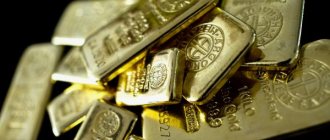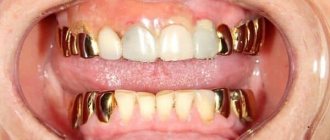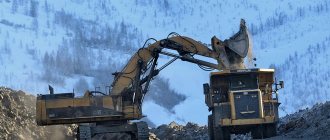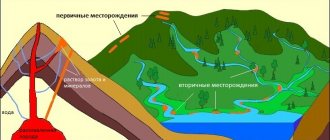Hello dear gold miners and those who are reading this article to keep up to date with the latest developments. Gold is a precious metal recognized as world money. That is why its deposits play an important role in the life of the country. And today we will talk about one famous place for gold mining - Bashkortostan.
From this article you will learn where gold is mined in Bashkiria, in what ways, you will get acquainted with the first major finds in this part of the country and with famous mining companies.
Is there gold in Bashkiria
The answer to this question is a resounding yes. It’s more difficult to figure out how much there is currently in the region. In 2007, the newspaper “Republic of Bashkortostan” published an interview with Vera Makarova, a researcher at the National Museum.
Experts calculated that in 2004, 170 tons of gold were mined in Bashkiria. The republic ranked 13th among gold-mining regions. Vera Makarova cited an interesting fact: out of 53 explored deposits, only 17 are used. All the rest are reserved.
In 2011, the media sharply raised the issue of large-scale gold and diamond mining. The head of the subsoil use department, Rasikh Khamitov, announced that one should not count on these minerals: there are much fewer of them in Bashkiria than in other regions.
Nevertheless, incredible discoveries are still talked about.
Uchalinsky Mining and Processing Plant (UGOK)
The Uchalinsky mine was originally a mine; the gold-bearing ore mined here was washed at a percolation plant. After the war, copper-zinc ore was explored nearby, so the mine needed to be reconstructed. Since 1954, open-pit mining of the Uchalinsky quarry began. Since 1968, the enrichment plant began working at full capacity; the mined copper-zinc ores turned out to be rich, and their enrichment made it possible to obtain fairly high-quality concentrates. For many years, copper and zinc concentrates obtained from ore provided raw materials for copper smelters in the Middle Urals and the Chelyabinsk Zinc Plant. UGOK ranks third in the country in the production of copper concentrate; more than two-thirds of Russian zinc is also mined here.
The time came, ore reserves were depleted, mining was stopped, the quarry at the time of closure was huge: 900x1800 m and 380 m deep. However, deeper-lying ore bodies were found and the Uchalinsky underground mine was founded here.
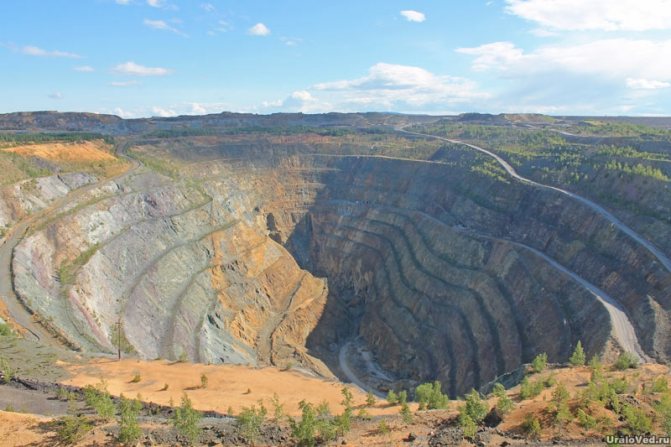
Not far from Uchaly in the Chelyabinsk region, a new deposit was found - Uzelginskoye and a second quarry was opened - Molodezhny. New, deeper deposits were also explored here, and naturally, the plant switched to underground development of ore reserves. Three underground mines are currently in operation.
Now the plant is routinely searching for new sources of raw materials. The Sultanovskoye deposit of copper-zinc ores, located on the eastern outskirts of the Chelyabinsk region, has been explored and is being developed by open pit mining. Thus, opportunities to replenish ore reserves are constantly being sought and new deposits are being developed.
A jasper belt is located parallel to the copper one, and at the plant, naturally, they took up stone cutting. Products made from Aushkul, Kalkan and many other jaspers are known not only in Russia, but also abroad.
This is the evolution of the Uchalinsky GOK - from open-pit mining to underground ore mining. And a constant search for raw materials.
Historical reference
The “Gold Rush” began more than 250 years ago after the discovery of alluvial gold in the north of the Uchalinsky region of Bashkiria along the valleys of 7 rivers. The “Golden Belt” had a length of more than 300 km. Prospectors and ordinary residents rushed to search for treasures. A Mining Charter was created, which stated that gold miners must pay a tax of 10% on the total volume of gold mined. Gold mining continued for 93 years.
Expert opinion
Vsevolod Kozlovsky
6 years in jewelry making. Knows everything about samples and can identify a fake in 12 seconds
In 1897, 600 mines and 1,200 adits operated in Bashkiria, which took part in the extraction of precious metal.
Intensive development of gold deposits began before the First World War. In 1912, a mining joint-stock company was created.
First major finds
After the start of the “gold rush”, A.S. was the first to apply. Zhemchuzhnikov. He had 2 groups of mines, one of which discovered gold deposits. In total, Zhemchuzhnikov’s team found 60 tons of gold in Bashkiria.
An ingot weighing about 16-17 kg, which was found in the Uchalinsky district before the revolution, is being actively discussed. According to reliable sources, it was presented to the king.
The next major find occurred in 1992 in the Baymak region of Bashkiria. The nugget weighing 5 kg was called the “Irendyk Bear”.
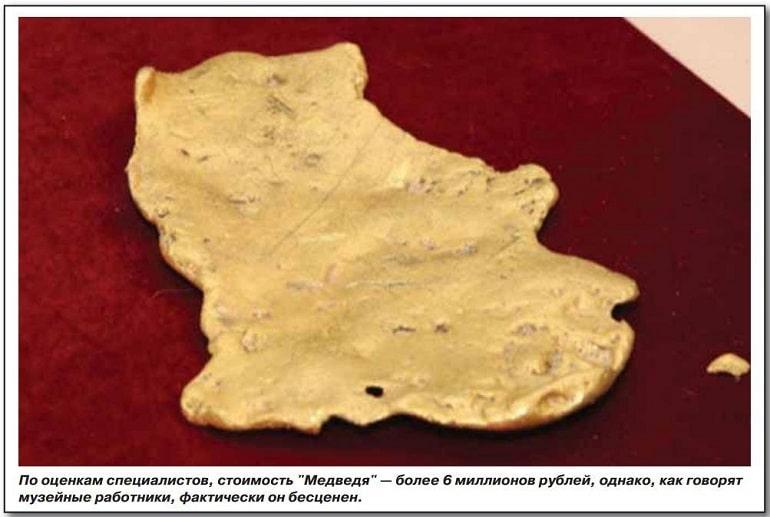
Buribayevsky GOK
The southernmost district in the east of Bashkortostan is Khairullinsky. It was mentioned above that experts call two copper ore zones - Uchalinskaya and Podolskaya. So, it is in the Khairullinsky region that this same Podolsk zone is located, and there are several copper deposits in it (it seems that in southern Bashkiria almost every hill is a copper deposit).
About a hundred kilometers south of Sibay, and here is another quarry - Buribayevsky. Since Buribay stands on the Tanalyk River, its history resembles that of Baymak. Increased gold content was found in manually mined rocks. At first it was washed, although in contrast to traditional artisanal washing, the noble metal was already extracted in the first half of the 20th century using more modern methods - amalgamation, and subsequently cyanidation. Later, the ore mined in the open pit was exported to the Baymak gold-copper plant, and the richest ones were even exported.
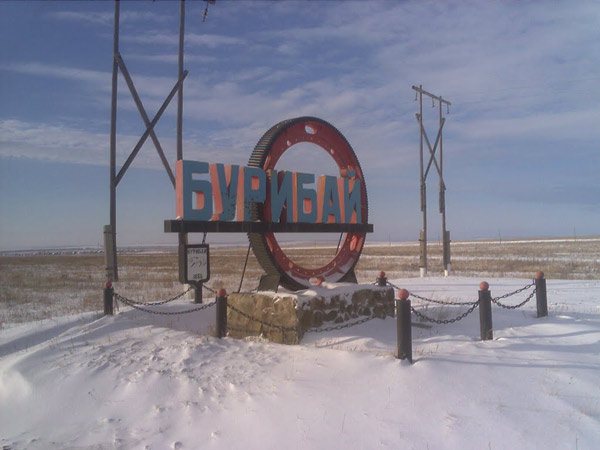
Photo — kylivan
The mine existed until the reserves of gold ore were depleted, and it so happened that during the Second World War, when the need for copper increased, the Buribayevskoe mine management was reoriented to the extraction and enrichment of copper ore. The concentrate was processed in Baymak at the copper plant and at the Mednogorsk copper and sulfur plant (this is a hundred kilometers to the southwest, already in the Orenburg region).
Intensive exploitation of the Buribayevsky quarry led to the depletion of easily accessible reserves of copper ore and required an active search for new deposits. Several new deposits were found and began to be developed in nearby territories. First, the ore was mined open-pit, then underground, and enriched at the Buribayevsky factory. It was already mentioned just above that the processing of ores from some deposits is also carried out at the Sibay factory.
With the discovery of the large Yubileiny deposit, the Khairullinsky GOK was founded. A quarry was opened and a processing plant was built. The question of building a plant that processes concentrates into metals has been postponed until better times.
An acute transport problem hinders efficient work. The decision to build the Sibai-Sara branch, on the Orenburg section of the railway, was made more than half a century ago; the construction of an embankment even began, but there is still no road. So we have to transport ore to Buribai and Sibai by road. The tension was somewhat eased by the launch of the first stage of the processing plant at the Yubileiny deposit.
The second problem is the investment required for the construction of new mines, and here the arrival of the northern neighbor in southern Bashkiria, the Ural Mining and Metallurgical Company (UMMC), which, as already mentioned, needed copper concentrates for its factories, helps. The company has significant stakes in South Bashkir mining and processing enterprises, for example, it built the Kamagansky underground mine in Sibay, began construction of the first underground mine at the Yubileinoye deposit, and launched the mentioned enrichment plant.
At this point, the story about the copper deposits of the Khairullinsky region can be completed, bearing in mind that there is another mining and processing complex ahead that needs to be mentioned.
Geographic location and landscape features
The Republic of Bashkortostan is located in Eastern Europe, in the Southern Urals and adjacent territories - the Cis-Urals and a small part of the Trans-Urals.
It borders on the Perm, Chelyabinsk, Orenburg and Sverdlovsk regions, as well as the republics of Tatarstan and Udmurtia. The length from north to south is 550 km, from west to east – 430 km. Area – 147 thousand km2.
Bashkiria is characterized by a variety of natural conditions. It can be roughly divided into 3 zones:
- The Bashkir Ural is a small mountainous area that occupies 1.5/4 of the entire area.
- Bashkir Cis-Urals - 2/3 of the entire area. It is a hilly plain.
- Bashkir Trans-Urals - 1/10 of the entire republic. A small strip that passes into the West Siberian Plain.
Tashbulatovo deposit - jasper of Bashkiria
The history of Ural jasper, according to archaeologists, began as much as one hundred thousand years ago. It was at this time that the Southern Urals were populated. The hardness of jasper made it possible to use it to create tools that were found in one of the very first Early Paleolithic sites in Russia. Several stone-processing workshops were also discovered there. The site is called Mysovaya, and it is located on the shore of Lake Tashbulatovo. It was near Lake Tashbulatovo that jasper was mined for the first time in the Urals.
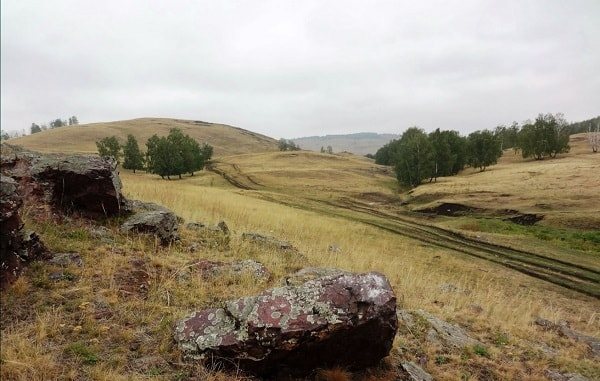
Tashbulatovskaya jasper, of course, is not the only one that was mined in ancient times. Products made from jasper were also found on Lake Uzunkul, on Cape Murat. There were countless numbers of these products—several thousand. It was a whole warehouse of ancient crafts and no less ancient tools, which were made from green Ural jasper. A stone was found near the lake, which played the role of an anvil - on it the craftsmen split pieces of solid rock.
What impressed the experts most was the exceptional variety of colors and shades of Ural jasper. Stone Age people used all this wealth, making various household items and weapons from this mineral.
On topic: Dalmatian Jasper - properties of the stone
The Urals are extremely rich in jasper deposits. In Bashkiria alone (namely, in the Bashkir Trans-Urals) there are more than two hundred deposits of this valuable mineral. Jasper is mined all over the world, but nowhere on the planet are there so many jasper deposits concentrated in one zone. The diversity of Bashkir jasper at one time attracted and impressed the famous academician Alexander Fersman, to whom the fate of the Ural jasper was never indifferent. He wrote about it that he does not know of another type of mineral that would represent such a wide palette of colors, shades and patterns. Alexander Fersman is known not only as a scientist, geologist and public figure, but also as a person who glorified South Ural jasper in his works.
Video on the topic: Search for jasper in Bashkiria
The floor in the Annunciation Cathedral of the Moscow Kremlin is laid with Ural jasper. Research by geologists has shown that minerals of Russian origin were used as floor cladding. With their variety of colors and noble shine, tiles made from jasper decorate the room and compare favorably with tiles made from other stones, which are also used for flooring. Over the centuries, the jasper floor has been polished by countless soles to a mirror shine, and when sunlight streams onto it, it is a mesmerizing sight.
On topic: Black jasper stone: properties
Small fragments of it were used as material to study whether Ural jasper was really used to cover the floor of the cathedral. Geologists conducted microscopic studies that showed that the same rocks are found in coal deposits. The glacier that rammed the Russian Plain fifteen thousand years ago destroyed and shifted the coal rocks of the Russian north. Based on these data, scientists have suggested that the beautiful jasper floor is of Russian origin.

The recent crisis has had a rather negative impact on many industries, including the processing of semi-precious and ornamental minerals in the Russian Federation. It did not bypass the Bashkir Trans-Urals and its stone-processing enterprises. But, fortunately, the stone processing industry is now on the rise again. After all, unique, incredibly beautiful minerals, suitable as ornamental materials, are mined in Bashkiria. Certain varieties of stones found in Russia simply do not exist anywhere else. But jasper deposits had and continue to have the highest value.
On topic: Red jasper - the magical properties of the stone
Today, several reputable stone processing plants operate in Bashkiria. Equipment for them is imported from Europe, and well-known Russian and foreign specialists provide consultations on the possibilities for further development of this industry. It did not take much time for the stone cutting and processing industries to operate at full capacity. In addition to jasper, granite, marble and other raw materials for the stone processing industries are mined and processed there. Thus, we can say that the mining and processing of stones, including jasper, in the Bashkir Trans-Urals is in full swing.
What mineral resources are there in Bashkortostan
In addition to gold, Bashkiria is rich in a variety of natural resources. Let's take a look at what mineral resources are being mined on the territory of the republic:
- peat, coal, natural gas, oil, brown coal;
- raw materials for chemical production - sulfur, barite, limestone, rock salt;
- gypsum, crushed stone;
- minerals - phosphorites, apatites, nitrate, sylvite;
- facing and ornamental stone, raw materials for optics;
- precious stones - smoky quartz, ruby grains, diamonds, jasper, rock crystal;
- carbonate raw materials;
- ores of zinc, copper, manganese, aluminum, iron;
- peat, zeolites, saprofel;
- cadmium, hot shale, lead, bauxite.
Main gold deposits in Bashkiria
On the territory of the republic there are 4 main deposits where gold is mined:
- Baymaksky district is a gold-polymetallic deposit.
- The Sakmaro-Tanalyk site is a vast placer deposit (the bulk of the pure gold mined in Bashkiria occurs in this zone).
- Beloretsk region has the largest concentrations of quartz-gold ores.
- Uchalinsky district is a gold sulfide deposit.
Expert opinion
Vsevolod Kozlovsky
6 years in jewelry making. Knows everything about samples and can identify a fake in 12 seconds
Important: On February 10, 2021, it published information that geologists who conducted research in the Novopetrovskaya area in search of copper pyrite ores in the Khaibulinsky district discovered deposits interspersed with gold and silver. The gold reserves of the Bashkir gold mining holding are estimated at 87 tons.
At the same time, there are many other areas that are not used by the state, but contain an impressive amount of precious metal placers. Among them: Atangulovskaya, Sultanovskaya, Tanalykskaya placers. At the moment they are being developed, but on a small scale.
Features of gold prospecting and mining in the Urals
The features of gold prospecting and mining in the Urals will be of interest to many. The most popular is the ore method (divided into mine and quarry). It is also considered the most expensive, so it is available exclusively to large companies. At placer deposits, gold is contained in large quantities in the soil, which is why its industrial mining is not the most profitable business. That is why there are crowds of miners operating there who use artisanal methods.
You may be interested in: Do-it-yourself gold washing tray: manufacturing rules
It is worth knowing that anyone can search for and mine gold in the Urals. For independent gold mining, it is necessary to draw up a contract agreement with any organization that has its own mine in the territory. If this is not done, the procedure will be considered illegal, which may lead to criminal or administrative liability. After mining, the only option for delivering gold is an agreement with the company. However, the price is not always pleasing.
You can mine gold in new areas. This is the most promising method. Especially in demand are the gold-bearing rivers of the Urals (on the map of Russia - all the rivers of the Ural region), mountain slopes, as well as places where rock masses move.
In addition, you can search for metal in waste placers. The probability of finding the material is high due to the fact that modern methods of finding aurum do not allow achieving one hundred percent efficiency. Prospectors even occasionally manage to discover small nuggets.
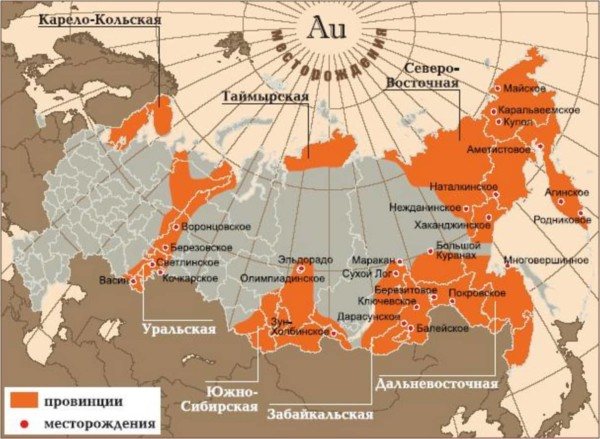
We can conclude that the Urals are one of the richest regions for seekers of gold, as well as other precious metals and stones. In principle, anyone with a little persistence, time and desire can find gold in the Urals. The main thing is to register the extraction legally and believe in yourself.
You can learn more about gold mining in the Urals from the video below.
By whom and how is it mined?
At the moment, Bashkortostan does not use all known clusters. For some time, the republic even put the deposits up for auction, but no buyers were found.
The reason for this disinterest is unknown.
Let's look at which mines produce and how they do it.
Mining companies
Currently, since 2015, mining has been carried out by:
- Mindyaksky mine;
- Tubinsky mine;
- JSC NPF Bashkir Gold Mining Company;
- 2 prospecting artels (on small placers).
Extraction methods
Large-scale gold mining is carried out using modern technologies using heap leaching. This method was mastered in Russia for the first time. It consists in the fact that the ore, stacked, is irrigated with a cyanide solution. This method allows you to recycle residual reserves.
For the extraction of alluvial gold, miners' trays and sieves are used - containers that are used for washing the soil.
